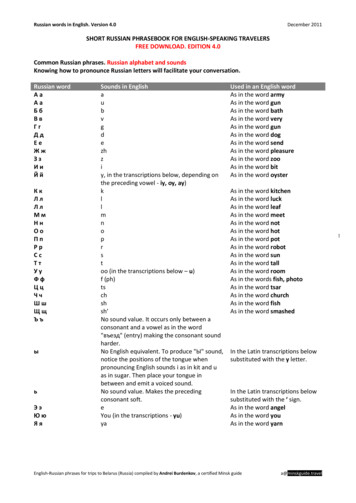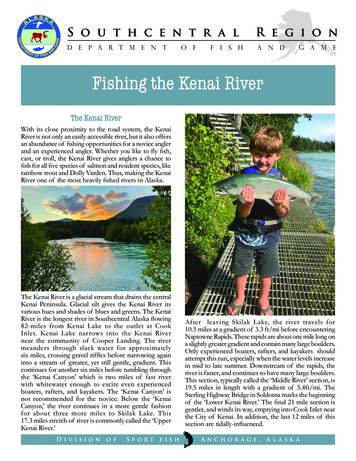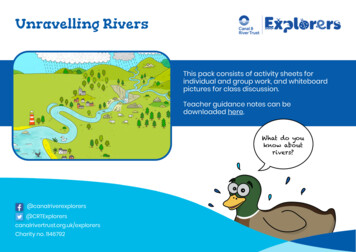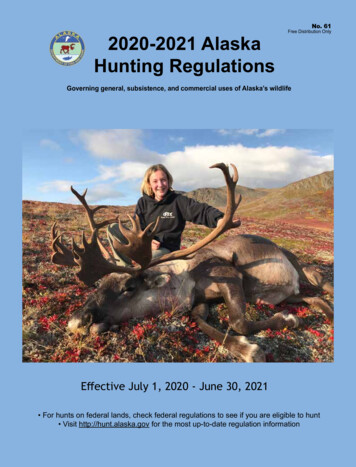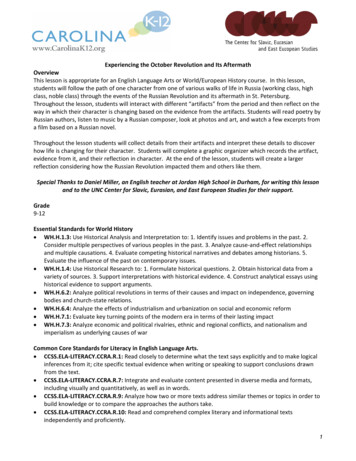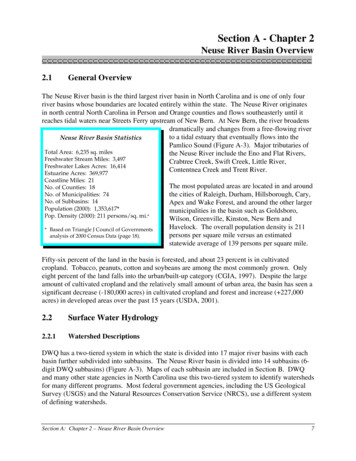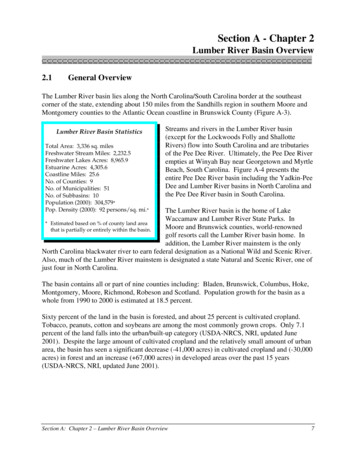
Transcription
S o u t h c e n t r a lR e g i o nDaep ar tmentofFishndGameFishing the Kenai RiverThe Kenai RiverWith its close proximity to the road system, the KenaiRiver is not only an easily accessible river, but it alsooffers an abundance of fishing opportunities for anovice angler and an experienced angler. Whetheryou like to fly fish, cast, or troll, the Kenai River givesanglers a chance to fish for all five species of salmon andresident species, like rainbow trout and Dolly Varden.Thus, making the Kenai River one of the most heavilyfished rivers in Alaska.The Kenai River is a glacial stream that drains the centralKenai Peninsula. Glacial silt gives the Kenai River itsvarious hues and shades of blues and greens. The KenaiRiver is the longest river in Southcentral Alaska flowing82-miles from Kenai Lake to the outlet at CookInlet. Kenai Lake narrows into the Kenai Rivernear the community of Cooper Landing. The rivermeanders through slack water for approximatelysix miles, crossing gravel riffles before narrowingagain into a stream of greater, yet still gentle, gradient.This continues for another six miles before tumblingthrough the “Kenai Canyon” which is two miles offast river with whitewater enough to excite evenexperienced boaters, rafters, and kayakers. The “KenaiCanyon” is not recommended for the novice. Below the“Kenai Canyon,” the river continues in a more gentlefashion for about three more miles to Skilak Lake. This17.3 miles stretch of river is commonly called the “UpperKenai River.”After leaving Skilak Lake, the river travels for10.5 miles at a gradient of 3.3 ft/mi before encounteringNaptowne Rapids. These rapids are about onemile long on a slightly greater gradient and containmany large boulders. Only experienced boaters,rafters, and kayakers should attempt this run,especially when the water levels increase in mid tolate summer. Downstream of the rapids, the river isfaster, and continues to have many large boulders. Thissection, typically called the “Middle River” section, is19.5 miles in length with a gradient of 5.4ft/mi. TheDivisionofSportfishSterling Highway Bridge in Soldotna marks thebeginning of the “Lower Kenai River.” The final 21 milesection is gentler, and winds its way, emptying intoCook Inlet near the City of Kenai. The final 12 miles ofthis section are tidally-influenced.There are about 40 species of fish in the Kenai River.There are resident fish such as rainbow trout andDolly Varden which spend their entire lifecycle inthe Kenai River; anadromous fish, such as Pacificsalmon and sea-run Dolly Varden which spend aportion of their lifecycle in the river and the otherportion of their lives in saltwater; and fish such asflounder or that are common to the intertidal area,which is a mixture of both fresh and salt water.Anchor age,Al a sk a
Upper Kenai River: From Kenai Lake downstream to Skilak LakeHealthy Bank StewardshipMost people understand healthy river systems areimportant for strong and healthy salmon populations.However, it is important to ensure that clean, healthyrivers don’t stop at the water’s edge. In fact, protectingand managing healthy streambanks and adjacentriparian areas are critical components to the overallhealth of a river system.By following the simple steps listed below, you canhelp maintain important habitat for salmon and begood stewards of the land. Use established trails to reach the river.Use established entry and exit points to get in andout of the river.Respect and abide by signs that close areas tofishing from the bank.Stand in the river to fish and don’t place your packor other gear on the vegetation.Pack out what you pack in, including discardedfishing line and tackle.Use the restroom in the provided facilities.Sport Fishing RegulationsVegetation along streambanks helps keep river waterclean by filtering out sediment and pollutants fromsurface and storm runoff, reduces peak flows duringrain and runoff events, slows flood waters, stabilizesstreambanks from excessive erosion, and helpsmoderate stream temperatures. Vegetated streambanksalso provide food and nutrients to fish and otheraquatic organisms, as well as, provide critical habitatfor rearing juvenile salmon. Any alteration to thestreambank area reduces its ability to carry out theseimportant functions, this includes repeat tramplingof the vegetation while trying to get to your favoritefishing spot. While out on the river, please be respectfuland follow any requirements landowners may have.Every year the Alaska Department of Fish and Game(ADF&G) releases four sport fishing regulationsbooklets for the Northern, Southcentral, Southeast,and Southwest areas. Sport fishing regulations specificto the Kenai River such as bag and possession limits,seasons, and tackle or bait limits can be found in thecurrent years Southcentral Sport Fishing RegulationsSummary booklet.These booklets are free of charge and are availableat ADF&G offices, wherever sport fishing licensesare sold, and online at www.adfg.alaska.gov. underthe “Regulations” tab. Before you cast out your line,make sure you read all regulations and AdvisoryAnnouncements and Emergency Orders for the areayou will be fishing. If you have any questions, pleasecontact the Soldotna ADF&G office at (907) 262-9368.Advisory Announcements & Emergency OrdersADF&G may release an Advisory Announcement andEmergency Orders to open, liberalize, close, or restrictany fishery at any time during times of biological need.
Emergency Orders usually affect Kenai River Chinook(king) salmon, Kenai River and Russian River sockeye(red) salmon, and Kenai River coho (silver) salmonfisheries.In the event an Emergency Order is issued,ADF&G attempts to post/release the AdvisoryAnnouncements and Emergency Orders a minimum of24-48 hours before it becomes effective whether it isopening, liberalizing, closing, or restricting a fishery.Anglers can find the Advisory Announcementsand Emergency Orders through the ADF&Gwebpage at www.adfg.alaska.gov, select the “SportFishing” webpage and under “Quick Links” select“News Releases/EOS” and select “Emergency Ordersand Advisory Announcements,” once there anglerscan select the region they intend to fish. After postingonline, ADF&G emails the Advisory Announcementsand Emergency Orders to newspapers, television andradio stations. Updates are also posted on the ADF&G- Sport Fishing Southcentral Alaska Facebook page.Anglers may also subscribe to receive email notificationsof the Advisory Announcements and Emergency Ordersthat would open, liberalize, close, or restrict a fisheryvia the following webpage ew. Subscribing is easy!Simply enter your email address and select the topic orarea you are interested in receiving information about.Weekly Fishing ReportsDuring the summer ADF& G posts weekly in-seasonfishing reports online and anglers will find these under“Fishing Reports” on the Sport Fishing webpage under“Fishing Information.” ADF&G staff also records theSoldotna Area fishing report on the Soldotna SportFishing hotline at (907) 262-2737. Anglers can alsosubscribe to receive the Fishing Reports when theysign up for email notifications.Chinook SalmonThe world’s record rod and reel Chinook or “king”salmon was caught in 1985 from the Kenai River, andweighed 97 lb.-4 oz. However, not all Kenai Riverking salmon are that large. Most Kenai Peninsula kingsalmon spend one year in fresh water, then migrate tosea when they are about 4 inches long. The length oftime in saltwater, how much food they find, and thegenetic composition of the fish all help to determinetheir final size.No one knows why king salmon return at differentages. Some king salmon return after only one year inthe ocean. These fish weigh only a few pounds, andare almost always fertile males. Others return aftertwo years and weigh 10-20 pounds and a majority ofthese fish are males. The majority of Southcentral kingsalmon weigh 25-60 pounds and some return after fiveyears at sea. King salmon of the same age will also varyin size from stream to stream, perhaps due to genetics.A “four-ocean” fish in lower Kenai Peninsula streamswill rarely grow to (and only a few exceed) 40 pounds.In the Kenai River, though, a 50-pound “four-ocean”Lower Kenai River: From Skilak Lake downstream to the mouth
fish is fairly common. The world record fish caughtin 1985 spent one year in freshwater, five years insaltwater and returned in its seventh year of life.Chinook Salmon Run TimingThe Kenai River supports two distinct Chinook salmonruns; an early-run and a late-run. The early-run usuallyenters the river in mid-May. Early-run fishing peaks inmid-June, and is over by the end of June. The early-runfish primarily head for smaller Kenai River tributariesto spawn. Late-run fish enter the river in early July,with the best fishing found from mid-to late July andare generally considered mainstem spawning fish.Chinook Salmon Fishery ManagementBoth Chinook salmon runs are intensively andconservatively managed by the Division of Sport Fishunder management plans outlined by the Alaska Boardof Fisheries. Special restrictions on bait, tackle, andharvestable sizes apply to both runs. The Divisionof Sport Fish uses the best technologies and mostaccurate methods available to estimate both the runstrength and the spawning escapement of Kenai Riverking salmon.The Division of Sport Fish primarily relies on twomethods to estimate run strength: 1) an in-river sonarprogram, and 2) an in-season creel survey/census whichconsists of ADF&G Fishery Technicians interviewinganglers on the Kenai River. The Division of Sport Fishthen estimates the spawning escapements - how manyfish have escaped harvest- by subtracting the creelcensus figure from the number of king salmon goingthrough the sonar counter. In order to ensure accuracy,additional measurements of run strength- harvest inthe commercial fishery, offshore test fishing, test netcatches in the river, and angler success rates, amongother methods - are also used.Kenai River Sonar ProgramsBoth of the Chinook salmon runs, as well as, the latesockeye salmon run are measured by state-of-the-artsonar equipment. The Chinook salmon sonar site isoperated by the Division of Sport Fish and is located atriver mile 14. The sockeye salmon sonar site is operatedby the Division of Commercial Fisheries, and is locatedat river mile 19.5.Sonar (ARIS) is currently used at the river mile 14 site.Sampling on both banks is controlled by electronicshoused in a tent located on the left bank of the river (leftbank facing downstream). Data from the right bank aretransmitted wirelessly to the left bank tent. All data filesare then transported to the ADF&G office for processing.ADF&G assesses in season Chinook salmon abundancebased on daily estimates of large fish ( 34 inches fromsnout to tip of tail as measured by the sonar). Estimatesof fish size are generated by measuring the video-likeimages of fish produced by ARIS. Post season estimates ofall Chinook salmon, regardless of size, are produced usingriver mile 9 netting data and river mile 14 sonar counts.Because both sport and commercial fishing regulationspartly depend on how many fish are estimated to havepassed through the sonar beams, the proper operationof this expensive and highly sensitive equipment iscritical to the entire salmon fishing industry. Submergedsonar equipment will entangled your fishing gear, giantChinook salmon, or boat propeller. Obey the traffic signsnear the sonar sites to avoid trouble.Sonar estimates are available on our website at www.adfg.alaska.gov, and click on “Fish Counts.” More informationabout the Chinook salmon sonar program can be found atwww.adfg.alaska.gov/index.cfm?adfg sonar.site&site 17.NorthTackle and Fishing MethodsWarning BuoyWarning BuoywFloerRivThere are three types of fishing techniques that arepopular with king salmon anglers. Each techniquestakes advantages of the fact that king salmon traveldeep, through the center of the river channel. Shoreanglers are at a slight disadvantage when fishing forKenai River king salmon. Fishing from a boat allowsanglers to drift with the current, allowing the lure tobounce along the bottom at the speed of the current.“Back bouncing” is a very popular method. The boat isconstantly under power and slowly backed down theriver. As the boat backs through a hole or drift, theangler bounces the lure along the bottom of the river.“Back trolling,” another popular method, involves theuse of a plug of the flatfish variety, such as a Kwikfish .A planer is attached ahead of the lure to take the lureto the bottom of the river. The boat is backed downriver under power.Fixed Partial WeirThe most common rig for drifting and back bouncingis a large Spin-N-Glo with fresh or preserved salmoneggs (when permitted) and enough weight to get thelure to the bottom. Since the lure is moving quiterapidly, clearer water increases the efficiency of thesetechniques. Much depends on the skill of the boatoperator, as well. Because there are a lot of boats onthe Kenai River, we suggest that the boat operatorconcentrate only on safe boat operation.
The Kenai River king salmon fishery is crowded, sobring along an ample supply of patience and courtesy.Know your boat and how to operate it. Be familiar withthe “rules of the river.” For example, the universal signalon the Kenai River of a “fish on” is a raised landing net.Give those boats the widest berth possible. On theKenai River, guided anglers are about twice as efficientas non-guided anglers. You can improve your chancesby hiring a guide, especially if you are either a noviceand/or you lack suitable equipment.sections of the Kenai River that are fly-fishing-only.Check the Southcentral Sport Fishing RegulationsSummary booklet before going fishing.Tackle and Fishing MethodsMost Kenai River sockeye salmon anglers use a streameror “Russian River Coho” fly, although some claim thatthe “Green Lantern,” “Comet,” or any shrimp patternall outperform the popular streamers. Also popular arered hooks with a bit of yarn tied on them. Weights areused to get the fly close to the bottom. The fly is castedout 10-15 feet into the current at about a 45-degreeangle upstream and allowed to “dead drift” with thecurrent until reaching its furthest downstream point.It is then retrieved and the action repeated.The most productive fishing areas are pools immediatelydownstream of shallow riffles, and mainstem close toshore. Sockeye salmon tend to hold in these areas beforemigrating through the riffles. Since this species travelsclose to shore, most sockeye salmon fishing takes placefrom the bank. Inexperienced sockeye salmon anglersoften wade or cast too far out, not realizing the fish areoften swimming right behind them.Sockeye SalmonRun TimingAlthough, there are two sockeye (red) salmon runson the Kenai River, the early-run sockeye salmondoes not present much opportunity for the KenaiRiver sport angler. It’s a small run, and the fish areheaded for the Russian River drainage. Anglers canfind more information about the Russian River fisheryby picking up a copy of the “Fishing the RussianRiver” publication from ADF&G offices or find iton the ADF&G Sport Fishing Brochures webpagehttp://www.adfg.alaska.gov/index.cfm?adfg he Kenai River late-run sockeye salmon enter thelower Kenai River in early July, peak in late July, andthe run generally is finished by early to mid-August.Most fish arrive during the last two weeks of July. Atthe peak of a good run, it is not uncommon to see sonarestimates of greater than 20,000 fish per day. These fishare headed for many tributary streams throughout thearea, as well as, the Russian River, the mainstem of theUpper Kenai River, and Kenai Lake to spawn.Sockeye Salmon Fishery ManagementBoth sockeye salmon runs are intensively managedby the Division of Sport Fish and the Division ofCommercial Fish under management plans outlinedby the Alaska Board of Fisheries. Special restrictionson bait and tackle apply to both runs, including specialCoho SalmonAlthough tradition holds that there are two coho(silver) salmon runs in the Kenai River, there areactually several periods of in-migration. The earlierfish arrive in late July, with more fish arriving early tomid-August through early October.Most anglers will boat to a favorite hole and anchor, ortie off to the bank. From the boat, they then fish freshor cured salmon roe (if permitted) on the bottom, oruse a Mepps , Pixee , or Vibrax lures. Since cohosalmon use the entire river to travel, there is moreopportunity for anglers to access more banks areasthat are productive for coho salmon than there are forking salmon. Many guides offer coho salmon chartersfor novice and/or those anglers who lack suitableequipment.
Pink SalmonBecause of their two-year lifecycle, pink (humpy)salmon numbers are highest on even-numbered years.Young and novice anglers favor pink salmon because ofthis species’ large numbers and aggressiveness towardsalmost any lure. Pink salmon also offer an excellentchallenge to anglers preferring light tackle.Most Kenai River pink salmon are taken downstreamfrom the Sterling Highway Bridge in Soldotna. Onegood place to try is at Cunningham Park, in the Cityof Kenai. Although, pink salmon age very rapidly afterentering freshwater, pink salmon are truly excellenttable fare if they are caught while fresh in the lowerriver, and cooked right away. Try them on the grillor smoke and can them for the winter. This species isfound in the Kenai River from late July through midAugust.Dolly VardenRainbow/Steelhead TroutThe Kenai River is home to trophy-sized wild rainbowtrout, and “off-season” fishing is a fly angler’s dream.The majority of the Kenai River rainbow trout areyear-round residents of the Kenai River, althoughsmall numbers of steelhead have been documented bythe Division of Sport Fish. The majority of these fishare released by anglers and this is a popular catchand-release fishery for anglers. Most rainbow troutfishing occurs from the Moose River upstream toSkilak Lake, and in the upper Kenai River, from SkilakLake upstream to Kenai Lake. Wet flies, streamerflies, spinning lures, and patterns imitating shrimp orsalmon roe are popular. The best time to fish is oftenfall when trout are feeding on salmon carcasses andeggs. Try fishing just downstream from a riffle area.Rainbow Trout ManagementSpecial conservative tackle and seasons apply. Checkthe Southcentral Sport Fishing Regulations Summarybooklet carefully before fishing for rainbow trout andsteelhead trout on the Kenai River.The Kenai River is assumed to have populations ofboth resident and sea run Dolly Varden. Resident DollyVarden are likely present the entire year throughoutthe river, and overwinter in Kenai and Skilak lakes.Preferred fishing areas are from Naptowne Rapidsupstream to Skilak Lake, and from the inlet of SkilakLake upstream to Kenai Lake. Anadromous DollyVarden enter the river in early July, with the runcontinuing into September. These fish spawn in thefall and overwinter in Kenai and Skilak lakes beforeheading back out to sea in April. Anglers intercept themin the lower river from mid-to late July. Like rainbowtrout, Dolly Varden are conservatively managed.Special conservative tackle and seasons apply. Checkthe Southcentral Sport Fishing Regulations Summarybooklet carefully.Lake Trout in Kenai & Skilak LakesLake trout are wild year-round residents of bothSkilak and Kenai lakes. They can sometimes be foundin the river at the outlets of these lakes, as well. Littleis known about lake trout populations in either lake.During the summer, knowledgeable anglers believe thatthe fish are in deeper water; for the most part, few fishare caught this time of year. In the fall and spring, laketrout may be found in the shallower areas of the lakesand/or lake outlets.
More anglers seem to be adopting a voluntary catchand-release philosophy when fishing for specificspecies. This catch-and-release method can be appliedto all resident species and salmon. If released correctly,these fish have a high probability of surviving. Toeffectively practice catch-and-release fishing, or torelease a fish which has been snagged, please do thefollowing:Catch & ReleaseAt one time or another, almost every angler accidentlyfoul-hooks or snags a fish. Snagging or trying to snaga fish is illegal in all freshwaters of Alaska. In someAlaskan fisheries, if you plan to release a fish, you maynot remove it from the water, even to take a photo.These fish must be released immediately, and if releasedcorrectly, it will suffer little to no permanent injuryand will spawn successfully. In some fisheries, onceyou remove a fish from the water (if you are legallyallowed to) then that fish is counted toward’s yourdaily possession limit. So check the Southcentral SportFishing Regulations Summary booklet and AdvisoryAnnouncements and Emergency Orders carefullybefore you go fishing.1. Land the fish as quickly as possible. Playing thefish to complete exhaustion reduces its energy.2. Keep the fish in the water while handling it. Thelonger the fish is out of the water, the lower thechance of survival.3. Never squeeze a fish or hold them by their jaw,gills, gill plate, or eyes. Never hold a fish upsidedown by its tail, as this can dislocate its back andcauses almost certain death.4. If you handle a fish with your hands, make sure towet them first. Dry and gloved hands can removethe slime layer off the fish. This is a protectivelayer on their skin which protects them fromdiseases and infections.5. If you need to hold the fish, do so by gentlyplacing one hand on the underside of the fishby the pectoral fins and the other hand near thebased of the tail. This will help avoid injury to theinternal organs.6. Use flies or artificial lures. Hooking mortality insome fish is much lower if they are caught withflies or lures instead of bait. If the fish is hookeddeeply, cut the leader and leave the hook in thefish. The hook will quickly dislodge or rust away.7. Some fish have “soft” mouths that are easily tornand should never be allowed to hang verticallyfrom a hook and line.8. In flowing water, position the fish with its bellydown and with the head facing into the current.Gently hold it there until its gills are working andit swims away on its own.
Kenai River Public Shoreline Access SitesPlease note that fees may be charged at some of the access sites. There are also many private facilities in the area.Please contact the appropriate Chamber of Commerce or visitor’s information center for information.River Mile 0: Surfcasting off the sandy beaches at the mouth of the KenaiRiver. A popular resident only personal use fishery occurs in July. North bankaccess: South on Spruce Drive in Kenai to large parking area. South bankaccess: Kalifornsky Beach Road to Cannery Road to small parking area, orfour-wheel drive onto beach.River Mile 5.0: Intertidal fishing at the DNR State Parks’ Kenai Flats StateRecreation Site at the Warren Ames Bridge. Small parking area, unimprovedsite, can be muddy.River Mile 6.5: Intertidal fishing and picnic area at the City of Kenai’sCunningham Park, off Beaver Loop Road in Kenai to small parking area,steps to boardwalk. RM 11.25 boat launching and day parking at the DNRState Parks’ Eagle Rock Boat Launch, Mile 5 of the Kenai Spur Highway.River Mile 11.25: Boat launching and day parking at the DNR -State Parks’Eagle Rock Boat Launch, Mile 5 of the Kenai Spur Highway.River Mile 12.5: Boat launching and day parking at the DNR State Parks’Pillars Boat Launch, Mile 4.2 of the Kenai Spur Highway.River Mile 15.5: day parking and bank fishing from DNR State Parks’Ceichanski Day use area.River Mile 30.5: Riverbank fishing, camping, picnic area at the DNR StateParks’ Funny River State Recreation Site, at Mile 12 of the Funny River Road.River Mile 31.0: Riverbank fishing, camping, picnic area at the DNR StateParks’ Morgan’s Landing State Recreation Site, Mile 84.5 of the SterlingHighway. Trail to boardwalk.River Mile 36.5: Riverbank fishing, boat launch, camping, and picnic areaat the DNR State Parks’ Izaak Walton State Recreation Site, near the MooseRiver bridge at Mile 82 of the Sterling Highway.River Mile 39.5: Riverbank fishing, boat launching, camping, and picnicareas at the DNR State Parks’ Bing’s Landing State Recreation Site, Mile80.5 of the Sterling Highway.Skilak Lake: Lake fishing, boat launching, camping, and picnic areas at theKenai National Wildlife Refuge’s two Skilak Lake campgrounds, Upper andLower. Off Skilak Lake Loop Road, Mile 58 and Mile 75 of the SterlingHighway.River Mile 69.5: Boat launching at Jim’s Landing, managed by the U.S.Fish and Wildlife Service’s Kenai National Wildlife Refuge. Off Skilak LakeLoop Road near Mile 58 of the Sterling Highway.River Mile 71:0: Riverbank fishing from pullouts near Mile 57 of theRiver Mile 17.0: Day use area DNR State Parks’ Big Eddy Day use area.River Mile 19.0: Fishing and day use area at DNR State Parks’ Skilok DayUse Picnic Area.River Mile 20.5: Riverbank fishing, camping, picnic area, parking, andboat launching at the City of Soldotna’s Centennial Campground, stepsto boardwalks. Off Kalifornsky Beach Road near the intersection of theSterling Highway.River Mile 21.0: Riverbank fishing and picnic area at the Soldotna Visitor’sCenter boardwalks, off the Sterling Highway, just south of the bridge.Steps in river.River Mile 22.0: Fishing, day use picnic area, boardwalk river access atSoldotna Creek Park. RM 22.5 fishing, parking, and day use area at theDonald E. Gilman River Center.River Mile 23.0: Riverbank fishing, camping, picnic area, and boat launchat the City of Soldotna’s Swiftwater Campground, off East Redoubt Avenuenear the intersection of the Sterling and Kenai Spur highways.River Mile 23.5: Day use and bank fishing at City of Soldotna Rotary Park.River Mile 25.75 & 26.75: Fishing and day use area at Kenai NationalWildlife Refuge Moose Range Meadows.River Mile 27.5: Boat launch and fishing at Kenai National Wildlife RefugeSterling Highway. Land in this area is managed by the Kenai National WildlifeRefuge. Unimproved, no facilities.River Mile 73.5: Boat launching (and riverbank fishing on the oppositebank) at the Kenai National Wildlife Refuge’s Russian River Ferry andSportsman’s Landing, Mile 55 of the Sterling Highway, just past CooperLanding. Riverbank fishing, camping, and picnic area at the U.S. ForestService’s Russian River Campground. Steps to boardwalks and trails alongthe Russian River down to the Kenai River. Entrance to campground at Mile52.5 of the Sterling Highway.River Mile 79.0: Riverbank fishing and camping at the U.S. Forest Service’sCooper Creek Campground, Mile 50.7 of the Sterling Highway, just pastCooper Landing.River Mile 83.0: Riverbank fishing and boat launching at the U.S. ForestService’s Cooper Landing boat launch. Mile 47.5 of the Sterling Highway,where Kenai Lake narrows into Kenai River, just before Cooper Landing.Kenai Lake: Lake fishing, creek fishing, boat launching, and picnic areaat the U.S. Forest Service’s Quartz Creek Campground. Mile 45 of theSterling Highway. The U.S. Forest Service also operates Trail River, Crescent,Ptarmigan, and Primrose campgrounds on Kenai Lake, but since the lakeis so large, these facilities are over 15 shoreline miles and over 25 highwaymiles from the Kenai River.boat launch on Keystone Drive.Sport Fishing Series produced by:Southcentral RegionAlaska Department of Fish and GameDivision of Sport FishThese opportunitiesfunded in part by FederalAid in Sport Fish andWildlife Restoration.333 Raspberry RoadAnchorage, Alaska 99518Sport Fish Information Center(907) 267-2218M-F 8am - 5 pmExcept on state holidaysThe Alaska Department of Fish and Game complies with Title II of the Americans withDisabilities Act of 1990. This summary is available in alternative communication formats. If youneed assistance, please contact the ADF&G ADA Coordinator at (907) 465-6078; TTY/ AlaskaRelay 7-1-1; or 1 (800) 770-8973.w w w . a d f g . a l a s k a . g o v5/2020
you like to fly fish, cast, or troll, the Kenai River gives anglers a chance to fish for all five species of salmon and resident species, like rainbow trout and Dolly Varden. Thus, making the Kenai River one of the most heavily fished rivers in Alaska. The Kenai River is a glacial stream that drains the central Kenai Peninsula.

